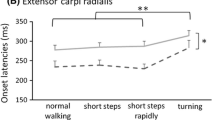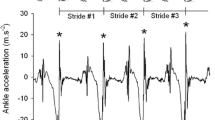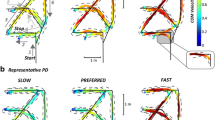Abstract
Older adults, as well as those with certain neurological disorders, may compensate for poor neural control of postural stability by widening their base of foot support while walking. However, the extent to which this wide-based gait improves postural stability or affects postural control strategies has not been explored. People with idiopathic Parkinson’s disease (iPD, n = 72), frontal gait disorders (FGD, n = 16), and healthy older adults (n = 32) performed walking trials at their preferred speed over an 8-m-long, instrumented walkway. People with iPD were tested in their OFF medication state. Analyses of covariance were performed to determine the associations between stride width and measures of lateral stability control. People with FGD exhibited a wide-based gait compared to both healthy older adults and iPD. An increased stride width was associated with an increase in lateral margin of stability in FGD. Unlike healthy older adults or iPD, people with FGD did not externally rotate their feet (toe-out angle) or shift their center of pressure laterally to aid lateral dynamic stability during walking but slowed their gait instead to increase stability. By adopting a slow, wide-based gait, people with FGD take advantage of the passive, pendular mechanics of walking.



Similar content being viewed by others
Abbreviations
- b z :
-
Offset in lateral direction
- b min :
-
Minimum margin of stability during single leg stance
- CoM:
-
Center of mass, coordinates (x, y, z)
- CoP:
-
Center of pressure, coordinates (ux, 0, uz)
- ∆u z :
-
Most lateral minus initial position of the CoP during single stance
- G :
-
Acceleration of gravity (9.81 m s−2)
- L :
-
Pendulum length
- v z :
-
CoM velocity in lateral direction
- ω 0 :
-
Eigenfrequency of pendulum = \(\sqrt {g/l}\)
- XcoM:
-
Extrapolated center of mass, coordinates (\(\xi\), 0, \(\zeta\))
References
Tinetti ME, Speechley M, Ginter SF (1988) Risk factors for falls among elderly persons living in the community. N Engl J Med 319:1701–1707. https://doi.org/10.1056/NEJM198812293192604
Maki BE (1997) Gait changes in older adults: predictors of falls or indicators of fear? J Am Geriatr Soc 45:313–320
Schrager MA, Kelly VE, Price R, Ferrucci L, Shumway-Cook A (2008) The effects of age on medio-lateral stability during normal and narrow base walking. Gait Posture 28:466–471. https://doi.org/10.1016/j.gaitpost.2008.02.009
J Jackson (1932) Selected Writings of John Hughlings Jackson, in: J. Taylor, G. Holmes, F. Walshe (Eds.), Hodder and Stoughton, London
Elble RJ (2007) Gait and dementia: moving beyond the notion of gait apraxia. J Neural Transm (Vienna) 114:1253–1258. https://doi.org/10.1007/s00702-007-0743-3
Nutt JG (2013) Higher-level gait disorders: An open frontier. Mov Disord 28:1560–1565. https://doi.org/10.1002/mds.25673
Dale ML, Nutt JG (2017) Geriatric neurological gait disorders. In: Tousi B, Cummings J (eds) Cleveland clinic neuro-geriatrics manual
Masdeu JC, Wolfson L, Grober E, Whipple R, Amerman P, Lantos G, Tobin JN (1989) Brain White-Matter Changes in the Elderly Prone to Falling. Arch Neurol 46:1292–1296. https://doi.org/10.1001/archneur.1989.00520480034016
Verghese J, Lipton RB, Hall CB, Kuslansky G, Katz MJ, Buschke H (2002) Abnormality of gait as a predictor of non-Alzheimer’s dementia. N Engl J Med 347:1761–1768. https://doi.org/10.1056/NEJMoa020441
Verghese J, LeValley A, Hall CB, Katz MJ, Ambrose AF, Lipton RB (2006) Epidemiology of gait disorders in community-residing older adults. J Am Geriatr Soc 54:255–261. https://doi.org/10.1111/j.1532-5415.2005.00580.x
N Giladi, V Huber-Mahlin, T Herman, JM Hausdorff (2007) Freezing of gait in older adults with high level gait disorders: Association with impaired executive function, in: 1349–1353. https://doi.org/10.1007/s00702-007-0772-y
Hof AL, Gazendam M, Sinke W (2005) The condition for dynamic stability. J Biomech 38:1–8
DA Winter (1995) ABC (anatomy, biomechanics and control) of balance during standing and walking, (No Title)
Curtze C, Buurke TJW, McCrum C (2024) Notes on the margin of stability. J Biomech 166:112045. https://doi.org/10.1016/j.jbiomech.2024.112045
Hof AL, van Bockel RM, Schoppen T, Postema K (2007) Control of lateral balance in walking: experimental findings in normal subjects and above-knee amputees. Gait Posture 25:250–258
Horak FB, Nashner LM (1986) Central programming of postural movements: adaptation to altered support-surface configurations. J Neurophysiol 55:1369–1381. https://doi.org/10.1152/jn.1986.55.6.1369
Rebula JR, Ojeda LV, Adamczyk PG, Kuo AD (2017) The stabilizing properties of foot yaw in human walking. J Biomech 53:1–8. https://doi.org/10.1016/j.jbiomech.2016.11.059
Gibb WR, Lees AJ (1988) The relevance of the Lewy body to the pathogenesis of idiopathic Parkinson’s disease. J Neurol Neurosurg Psychiatry 51:745–752. https://doi.org/10.1136/jnnp.51.6.745
Morel E, Armand S, Assal F, Allali G (2019) Is frontal gait a myth in normal pressure hydrocephalus? J Neurol Sci 402:175–179. https://doi.org/10.1016/j.jns.2019.05.029
Onder H (2019) Letter regarding the article entitled “Is frontal gait a myth in normal pressure hydrocephalus?” J Neurol Sci 404:68–69. https://doi.org/10.1016/j.jns.2019.07.005
Goetz CG, Fahn S, Martinez-Martin P, Poewe W, Sampaio C, Stebbins GT, Stern MB, Tilley BC, Dodel R, Dubois B (2007) Movement Disorder Society-sponsored revision of the Unified Parkinson’s Disease Rating Scale (MDS-UPDRS): process, format, and clinimetric testing plan. Mov Disord 22:41–47
Nieuwboer A, Rochester L, Herman T, Vandenberghe W, Emil GE, Thomaes T, Giladi N (2009) Reliability of the new freezing of gait questionnaire: agreement between patients with Parkinson’s disease and their carers. Gait Posture 30:459–463. https://doi.org/10.1016/j.gaitpost.2009.07.108
Nasreddine ZS, Phillips NA, Bédirian V, Charbonneau S, Whitehead V, Collin I, Cummings JL, Chertkow H (2005) The Montreal Cognitive Assessment, MoCA: a brief screening tool for mild cognitive impairment. J Am Geriatr Soc 53:695–699
Hof AL (2005) Comparison of three methods to estimate the center of mass during balance assessment. J Biomech 38:2134–2135. https://doi.org/10.1016/j.jbiomech.2005.03.029
Massen C, Kodde L (1979) Model for the description of left-right stabilograms. Agressologie 20:107–108
Kuo AD, Donelan JM (2010) Dynamic Principles of Gait and Their Clinical Implications. Phys Ther 90:157–174. https://doi.org/10.2522/ptj.20090125
Arvin M, Hoozemans MJM, Pijnappels M, Duysens J, Verschueren SM, van Dieën JH (2018) Where to Step? Contributions of Stance Leg Muscle Spindle Afference to Planning of Mediolateral Foot Placement for Balance Control in Young and Old Adults. Front Physiol. https://doi.org/10.3389/fphys.2018.01134
Jacobs JV, Horak FB (2006) Abnormal proprioceptive-motor integration contributes to hypometric postural responses of subjects with parkinson’s disease. Neuroscience 141:999–1009. https://doi.org/10.1016/j.neuroscience.2006.04.014
Stimpson KH, Heitkamp LN, Horne JS, Dean JC (2018) Effects of walking speed on the step-by-step control of step width. J Biomech 68:78–83. https://doi.org/10.1016/j.jbiomech.2017.12.026
Fling BW, Dale ML, Curtze C, Smulders K, Nutt JG, Horak FB (2016) Associations between mobility, cognition and callosal integrity in people with parkinsonism. NeuroImage Clin 11:415–422
Dale ML, Mancini M, Curtze C, Horak FB, Fling BW (2016) Freezing of gait associated with a corpus callosum lesio. J Clin Mov Disord 3:1–5
Fling BW, Curtze C, Horak FB (2018) Gait Asymmetry in People With Parkinson’s Disease Is Linked to Reduced Integrity of Callosal Sensorimotor Regions. Front Neurol 9:215. https://doi.org/10.3389/fneur.2018.00215
Donelan JM, Kram R, Kuo AD (2001) Mechanical and metabolic determinants of the preferred step width in human walking. Proc Biol Sci 268:1985–1992. https://doi.org/10.1098/rspb.2001.1761
Kubinski SN, McQueen CA, Sittloh KA, Dean JC (2015) Walking with wider steps increases stance phase gluteus medius activity. Gait Posture 41:130–135. https://doi.org/10.1016/j.gaitpost.2014.09.013
Zanardi APJ, da Silva ES, Costa RR, Passos-Monteiro E, dos Santos IO, Kruel LFM, Peyré-Tartaruga LA (2021) Gait parameters of Parkinson’s disease compared with healthy controls: a systematic review and meta-analysis. Sci Rep 11:752. https://doi.org/10.1038/s41598-020-80768-2
Morris ME, Huxham F, McGinley J, Dodd K, Iansek R (2001) The biomechanics and motor control of gait in Parkinson disease. Clin Biomech 16:459–470. https://doi.org/10.1016/S0268-0033(01)00035-3
McAndrew Young PM, Dingwell JB (2012) Voluntary changes in step width and step length during human walking affect dynamic margins of stability. Gait Posture 36:219–224
Visser JE, Voermans NC, Nijhuis LBO, van der Eijk M, Nijk R, Munneke M, Bloem BR (2007) Quantification of trunk rotations during turning and walking in Parkinson’s disease. Clin Neurophysiol 118:1602–1606. https://doi.org/10.1016/j.clinph.2007.03.010
Arvin M, van Dieën JH, Bruijn SM (2016) Effects of constrained trunk movement on frontal plane gait kinematics. J Biomech 49:3085–3089. https://doi.org/10.1016/j.jbiomech.2016.07.015
Buurke TJW, van de Venis L, Keijsers N, Nonnekes J (2023) The effect of walking with reduced trunk motion on dynamic stability in healthy adults. Gait Posture 103:113–118. https://doi.org/10.1016/j.gaitpost.2023.05.004
Best AN, Wu AR (2020) Upper body and ankle strategies compensate for reduced lateral stability at very slow walking speeds. Proceed Royal Soc B Biol Sci 287:20201685. https://doi.org/10.1098/rspb.2020.1685
Funding
This work was supported by the National Institutes of Health (2R01AG006457). Carolin Curtze was supported by the Center of Biomedical Research Excellence grant (P20GM109090) from NIGMS/NIH, and by a NASA EPSCoR grant (80NSSC18M0076). Marian L. Dale receives research support from the NIH (K23NS121402-01).
Author information
Authors and Affiliations
Contributions
CC: study design, data analysis, figures, statistical analysis, drafting manuscript, literature search. VVS: statistical analysis, interpretation of results, revise manuscript. AMS: figures, statistical analysis, revise manuscript. MLD: study design, screen subjects, interpretation of results, drafting manuscript, literature search. JGN: study design, screen subjects, interpretation of results, revise manuscript. MM: study design, supervise project, interpretation of results, revise manuscript. FBH: study design, supervise project, interpretation of results, revise manuscript. All authors approved the final version.
Corresponding author
Ethics declarations
Conflicts of interest
Carolin Curtze has no conflict of interest to report. Vrutangkumar V Shah is employed by APDM Wearable Technologies of Clario that may have a commercial interest in the results of this research and technology. This potential conflict of interest has been reviewed and managed by OHSU. Alexa M Stefanko has no conflict of interest to report. Marian L. Dale has served as a consultant for Synergic Medical Technologies and Cognito Therapeutics. John G Nutt has no conflict of interest to report for this work. Martina Mancini has no conflict of interest to report for this work. Fay B Horak is employed part-time by APDM Wearable Technologies of Clario that may have a commercial interest in the results of this research and technology. This potential conflict of interest has been reviewed and managed by OHSU.
Rights and permissions
Springer Nature or its licensor (e.g. a society or other partner) holds exclusive rights to this article under a publishing agreement with the author(s) or other rightsholder(s); author self-archiving of the accepted manuscript version of this article is solely governed by the terms of such publishing agreement and applicable law.
About this article
Cite this article
Curtze, C., Shah, V.V., Stefanko, A.M. et al. Stride width and postural stability in frontal gait disorders and Parkinson’s disease. J Neurol (2024). https://doi.org/10.1007/s00415-024-12401-5
Received:
Revised:
Accepted:
Published:
DOI: https://doi.org/10.1007/s00415-024-12401-5




